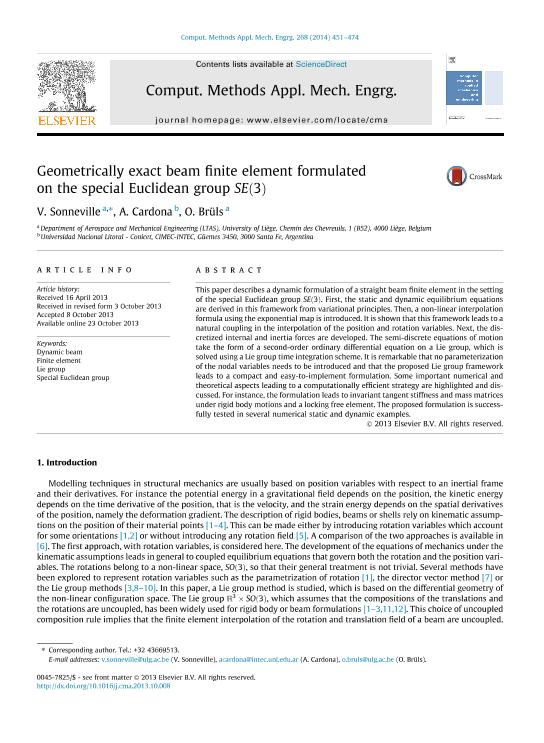Artículo
Geometrically exact beam finite element formulated on the special Euclidean group SE(3)
Fecha de publicación:
03/2014
Editorial:
Elsevier Science Sa
Revista:
Computer Methods in Applied Mechanics and Engineering
ISSN:
0045-7825
Idioma:
Inglés
Tipo de recurso:
Artículo publicado
Clasificación temática:
Resumen
This paper describes a dynamic formulation of a straight beam finite element in the setting of the special Euclidean group SE(3). First, the static and dynamic equilibrium equations are derived in this framework from variational principles. Then, a non-linear interpolation formula using the exponential map is introduced. It is shown that this framework leads to a natural coupling in the interpolation of the position and rotation variables. Next, the discretized internal and inertia forces are developed. The semi-discrete equations of motion take the form of a second-order ordinary differential equation on a Lie group, which is solved using a Lie group time integration scheme. It is remarkable that no parameterization of the nodal variables needs to be introduced and that the proposed Lie group framework leads to a compact and easy-to-implement formulation. Some important numerical and theoretical aspects leading to a computationally efficient strategy are highlighted and discussed. For instance, the formulation leads to invariant tangent stiffness and mass matrices under rigid body motions and a locking free element. The proposed formulation is successfully tested in several numerical static and dynamic examples.
Palabras clave:
Dynamic Beam
,
Finite Element
,
Lie Group
,
Special Euclidean Group
Archivos asociados
Licencia
Identificadores
Colecciones
Articulos(CIMEC)
Articulos de CENTRO DE INVESTIGACION DE METODOS COMPUTACIONALES
Articulos de CENTRO DE INVESTIGACION DE METODOS COMPUTACIONALES
Citación
Sonneville, V.; Cardona, Alberto; Brüls, O.; Geometrically exact beam finite element formulated on the special Euclidean group SE(3); Elsevier Science Sa; Computer Methods in Applied Mechanics and Engineering; 268; 3-2014; 451-474
Compartir
Altmétricas




